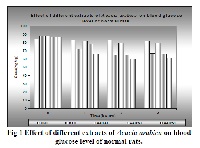Hypoglycemic and antihyperglycemic effect of different extracts of acacia arabica lamk bark in normal and alloxan induced diabetic rats
Keywords:
Diabetes, antidiabetics, Acacia arabica, baboolAbstract
Acacia arabica commonly known as babool are used in traditional Indian medicine for treatment of diabetes mellitus. The hypoglycemic effect of aqueous extract (hot and cold water) and hydroalcoholic extract of Acacia arabica was investigated. Oral administration of cold water extract of Acacia arabica bark to diabetic and normal rats at a dose of 400 mg/kg body weight resulted in significant reduction of blood glucose, cholesterol and triglycerides. Phytochemical investigations found that phenolic compounds are presents in Acacia arabica extracts. The cold water extract of Acacia arabica was found to reduce blood glucose level to its normal level with in seven days. Histological studies of the β- cells show its action on pancreas.
References
Nagappa AN, Thakurdesai PA, Venkat Rao
N, Singh Jiwan. Antidiabetic activity of
Terminalia catappa Linn fruits. Journal of
Ethnopharmacology 2003; 88 (3): 45-50.
Giugliano D, Ceriello A, Paolisso G.
Oxidative stress and diabetic vascular
complications. Diabetes Care 1996; 19:
–267.
Van Dam PS, Van Asbeck B S, Erkelens
DW, Marx JJM, Gispen WH, Bravenboer
B. The role of oxidative stress in
neuropathy and other diabetic
complications. Diabetes Metabolism
Reviews 1995;11: 181–192.
Carini M, Adlini G, Furlanetto S, Stefani
R, Facino RM. LCcoupled to ion-trap MS
for the rapid screening and detection of
polyphenol antioxidants from Helichrysum
stoechas. Journal of Pharmaceutical and
Biomedical Analysis 2001;24: 517–526.
Czinner E, Hagymasi K, Blazovics A, Kery
A, Szoke E, Lemberkovics E. In vitro
antioxidant properties of Helichrysum
arenarium (L.) Moench. Journal of
Ethnopharmacology 2000; 73: 437–443.
Schinella GR, Tournier HA, Prieto, JM,
Mordujovich de Buschiazzo P, Rio JL.
Antioxidant activity of anti-inflammatory
plant extracts. Life Sciences 2002;70:
–1033
S¨uzgec S, Meric li AH, Houghton P, C¸
ubukc¸u, B. Flavonoids of Helichrysum
compactum and their antioxidant and
antibacterial activity. Fitoterapia 2005; 76:
–272
Tepe B, S¨okmen M, Akpulat AH, S¨okmen
A. In vitro antioxidant activities of the
methanol extracts of four Helichrysum
species from Turkey. Food Chemistry
;90: 685–689.
Chandel BS, shah NM and Tripathi RM. in
vitro antibacterial activity of acacia arabica
bark. Indian journal of indigenous
medicines 1993;9(1/2): 77-79.
Oliver-Bever B. Medicinal Plants in
Tropical West Africa. Cambridge
University Press, London, pp. 1986; 245–
Ivorra MD, Paya M, Villar A. A review of
Natural Products and Plants as Potent
antidiabetic drugs. Journal of
Ethnopharmacology 1989;27 (3): 243–275.
Chakravarthy BK, Gupta S, Gambir SS,
Gode KD. Pancreatic beta cell
regeneration. A novel antidiabetic
mechanism of Pterocarpus marsupium
Roxb. Indian Journal of Pharmacology
;12: 123–127.
Manickam M, Ramanathan M,
Farboodinay Jahromi, MA, Chansouria
JPN, Ray AB. Antihyperglycemic activity
of phenolics from Pterocarpus marsupium.
Journal of Natural Products1997; 60: 609–
Aruna RV, Ramesh B, Kartha VN. Effect of
betacarotene on protein glycosylation in
Alloxan nduced diabetic rats. Indian Journal
of Experimental Biology 1999;37:399-401.
Giordano BP, Thrash W, Hollenbaugh L,
Dube WP, Hodges C, Swain A, Banion CR,
Klingensmith, GJ . Performance of seven
blood glucose testing systems at high
altitude. Diabetes Education 1989; 15: 444–
Roeschlau P, Bernt E, Gruber W.
Enzymatic determination of total
cholesterol in serum. Zeitschrift fur
Klinische Chemie und Klinische Biochemie
;12: 226
Bowers LD. Kinetic serum creatinine
assays I. The role of various factors in
determining specificity. Clinical Chemistry
;26: 551– 554.
Kar A, Choudhary BK, Bandyopadhyay
NG. Comparative evaluation of
hypoglycemic activity if some Indian
medicinal plants in alloxan diabetic rats.
Journal of Ethanopharmocology 2003;84:
–108.
Jayakar B, Rajkapoor B and Suresh B.
Effect of Caralluma attenuate in normal
and alloxan induced diabetic rats. Journal of
Herbal Pharmacotherapy 2004;4: 35–40.
Shalev A. Hope for insulin mimetic oral
antidiabetic drugs. European Journal of
Endocrinology 1999:141: 561–562.
De Sousa E, Zanatta L, Seifriz I,
Creczynski-Pasa TB, Pizzolatti MG,
Szpoganicz B and Silva FRMB.
Hypoglycemic effect and antioxidant
potential of kaempferol-3,7-O-(_)-
dirhamnoside from Bauhinia forficate
leaves. Journal of Natural Products 2004;
: 829–832.
Jorge AP, Horst H, Sousa Ede, Pizzolatti
MG and Silva FR. Insulinomimetic effects
of kaempferitrin on glycaemia and on 14Cglucose uptake in rat soleus
muscle.Chemico Biological Interactions
; 149: 89–96.
Stanely P, Mainzen P and Menon VP.
Hypoglycemic and other related actions of
Tinospora cordifolia roots in alloxaninduced diabetic rats. Journal of
Ethnopharmacology 2000; 70: 9–15.
Verspohl EJ. Recommended testing in
diabetes research. Planta Medica 2002; 68:
–590.



